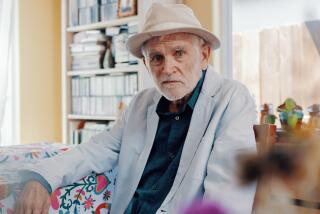Review: How L.A.’s ’60s movements fought for justice — and sometimes even achieved it
- Share via
Postwar Los Angeles was a glossy postcard of progress: Its entertainment, aerospace and auto industries were humming along, the weather was always perfect, and the price was right for that suburban dream home where you could tan to a crisp next to your kidney-shaped pool. It was a great time to be alive … if you were white.
For everyone else, it was “apartheid,” according to a member of a 1959-60 commission studying Southern California’s urban issues.
That’s the state of the city at the outset of “Set the Night on Fire: L.A. in the Sixties.” Authors Mike Davis and Jon Wiener unfurl a racist metropolis where politicians are in the pocket of the 1 percent, violent cops literally get away with murder and the local press — particularly the Los Angeles Times — is in on the fix. As James Baldwin observed, “there is … no distance between Birmingham and Los Angeles.”
Non-whites, those 1 million people of African, Asian and Mexican ancestry living on the fringes, were simply “edited out of utopia,” toiling invisibly in segregated communities like San Gabriel, East L.A. and Watts as villains like LAPD chief William Parker, Mayor Sam Yorty and governors Pat Brown and Ronald Reagan served the status quo. How bad was it? In 1964, the LAPD openly wore Barry Goldwater for president badges.
The ‘60s are remembered as a perfect storm of rebellion, but our memories are often shaped by repetitive archival news footage tattooed onto our brains. “Set the Night on Fire” fills in many blanks, focusing mostly on the movements emerging from South and East L.A. — the struggle for fair housing, the fight to integrate schools and jobs — while also excavating the forgotten core of L.A. resistance, illuminating those who often took life-risking steps to expose injustice.
It’s a dense, detailed read, but for those who craving an in-the-weeds narrative of the city’s diverse movements during the tumultuous 1960s, “Set the Night on Fire” is authoritative and impressive. It works fine for skimmers, but the book’s message really resonates as a whole: Progress is slow, painful and often dangerous but ultimately possible and worth the fight.
The Times Opinion section reflects on the uprising that shook the streets of Los Angeles a half-century ago.
With pedigrees as activists and urban historians, Davis (“City of Quartz”) and Wiener (“How We Forgot the Cold War”) craft multifaceted accounts of seminal events like the Watts uprising. But they also deliver detailed histories of lesser-known rebel operators: the Los Angeles Free Clinic, the Ash Grove, The Free Press, screenwriter Budd Schulberg’s involvement with the Watts Writers Workshop, and rebellious Catholic nun (and pop artist) Sister Corita Kent.
There are few outright triumphs in this history, but L.A.’s pioneering gay liberation actions did successfully lay groundwork for a unified and long-lived movement. The authors describe 14 lewd conduct arrests at an Echo Park club called the Black Cat on New Year’s Eve 1967, which begot a 500-person protest that predated New York’s Stonewall uprising by two years. And so it began: a gay-in at Griffith Park in May 1968; the country’s first gay pride parade two years later in Hollywood.
And the Watts rebellion spurred a cultural renaissance in the community, from the building of the Watts Towers to the writers workshop and Horace Tapscott’s UGMAA (Union of God’s Musicians and Artists Ascension), which became the house band of the black power movement.
Dozens of seemingly unrelated movements are covered, but almost all navigated a common foe — an establishment that would do almost anything to squash them. There are countless accounts of shady politicians and violent law enforcement agencies whose deeds went unpunished as these groups fought desperately for what they believed in. “Set the Night on Fire” underlines — with zero ambiguity — a racist system so entrenched as to be virtually invincible.
Though they catalog these fights with the fervor of true believers, the authors don’t hesitate to highlight the activists’ shortcomings — the politicking, power struggles and missteps. For example, they believe the black community suffered because too many groups, ideologies and charismatic leaders jostled for followers disenchanted with civil-rights incrementalism, becoming more of a competition than a community.
Among them: Ron Karenga’s back-to-Africa Us movement; the Stokely Carmichael-led Student Nonviolent Coordinating Committee (SNCC); and the more extreme Nation of Islam, which The Times described as “dedicated to the extermination of the white race.”
When they did find common ground, it was fleeting. Leaders from SNCC, the Black Panthers and Us did share a stage at a Free Huey (Newton, of the Panthers) rally at the Sports Arena in February, 1968 — Davis and Wiener call it “the high point for black unity and the proximate cause of its decline.” The groups tussled over everything from the order of the speakers to the disbursement of funds raised.
It’s not always the big issues that motivate community action. “Set the Night on Fire” describes revolutions triggered by seemingly trivial events. The Chicano blowups of 1968 were sparked by a banned production of “Barefoot in the Park” at Wilson High School. The principal pulled the plug after the final dress rehearsal, declaring that a line in the play was too risqué. The next day several hundred kids, including 12-year-olds from a nearby junior high school, walked out of their first class. The principal called the police and kids were suspended. It marked, according to the authors, “the emergence of a new, militant Chicano identity.” This culminated in the 1970 Chicano Moratorium on the day of a much greater outrage: Journalist Ruben Salazar was killed inside East L.A.’s Silver Dollar Bar after he was hit by a tear gas canister fired by county Sheriff Thomas Wilson. The sheriff was never charged or reprimanded for his action.
Not surprisingly, the local political needle really moved only after middle-class white kids were pummeled at an anti-Vietnam War protest in Century City in front a hotel at which President Lyndon Johnson was dining in 1968. “White liberals on the Westside had suddenly experienced firsthand the brutality that Blacks had been protesting against for years,” the authors write. The action led to the rise of former cop and city councilman Tom Bradley — who was black but hardly radical. Bradley’s coalition was led by Westside liberals, and he publicly rejected the endorsement of Black Panther Bobby Seale. He almost defeated incumbent mayor Sam Yorty in 1969 but beat him handily four years later, beginning a 20-year run at City Hall.
“Set the Night on Fire” is an essential reference to L.A.’s rich history of civil unrest, with a hopeful undercurrent. Movements can and often do force change. Long after the 1960s ended, the commitment to resistance remains a powerful tool.
Set the Night on Fire
By Mike Davis and Jon Wiener
Verso: 800 pages, $34.95
More to Read
Sign up for our Book Club newsletter
Get the latest news, events and more from the Los Angeles Times Book Club, and help us get L.A. reading and talking.
You may occasionally receive promotional content from the Los Angeles Times.









